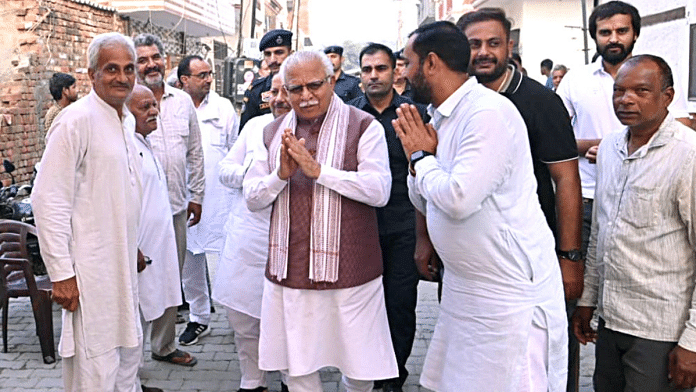Gurugram: The Punjab and Haryana High Court declared Haryana’s attempt to denotify land acquired for the Dadupur-Nalvi canal project as legally untenable, citing inconsistencies with the law and procedural lapses.
In its judgment pronounced 20 December, the court declared ‘unconstitutional’ the contentious Section 101A of the Right to Fair Compensation Transparency in Land Acquisition, Rehabilitation and Resettlement Act, 2013.
Enacted in 2017 and made retrospective from 1 January, 2014, the above-mentioned section authorised the Haryana government to de-notify acquired land under the Land Acquisition Act, 1894 if it deemed the public purpose for which it was acquired “unviable or non-essential.” The government could compensate landowners with damages or alternative land as well as recover compensation if the land was returned.
Through a policy dated 14 September, 2018, the Haryana government had elaborated the procedures for such de-notifications. However, the section faced widespread criticism for its retrospective application and alleged arbitrariness.
The HC ruling has brought the Dadupur-Nalvi project—a symbol of bureaucratic mismanagement and political indecision—back into the spotlight.
Any deprivation of property must be carried out strictly by the authority of law, the division bench of Justices G.S. Sandhawalia and Harpreet Kaur Jeevan said, adding that the Haryana government’s attempt to circumvent established procedures also amounted to a violation of constitutional rights.
Since the Dadupur-Nalvi land was acquired under the Land Acquisition Act, 1894, the provision does not apply, it added.
The state government’s reliance on the yet-to-be-assented Section 101A to de-notify the land was premature and legally invalid, it added. The amendment bill, passed by the Haryana Assembly in 2017, is still awaiting Presidential assent.
The judgment came on a bunch of petitions wherein the consideration pertained to the constitutionality of Section 101A of the Act.
The primary petitions involved landowners from various districts in Haryana whose lands were de-notified under the section. Many of them had already received compensation, and in some cases, land was partially developed before the government sought to withdraw the acquisition.
A prominent case involved land in Sirsa, where the state sought to denotify land after the court-ordered compensation enhancements made the acquisition costlier than anticipated. Similarly, in Gurugram, infrastructure worth Rs 42 crore, including a 220kV substation, became obsolete due to de-notification.
Project mired in trouble
The Dadupur-Nalvi Canal Project was conceived in the 1980s to irrigate farmlands and recharge groundwater in Haryana’s Yamunanagar, Kurukshetra, and Ambala districts. It envisaged a 72-km canal to channel water from the Sutlej-Yamuna Link (SYL) canal.
However, prolonged legal battles over the SYL rendered Dadupur-Nalvi a rain-fed canal instead of the envisioned perennial system. Moreover, the project seemed to be undertaken in the wrong order.
The project, according to the Comptroller and Auditor General (CAG), was initiated without conducting any survey to assess its feasibility or seeking input from the local villagers. The entire expenditure was ‘wasteful’, it added.
While the Haryana irrigation department claimed that the project contributed to groundwater recharge in the area, the CAG dismissed this justification stating it was unconvincing since the primary goal of providing canal irrigation to 92,532 hectares of land remained unachieved.
Over the years, successive governments poured money into the project without clear outcomes. Haryana acquired 1,019 acre of land, paying Rs 75.98 crore initially and later Rs 116.35 crore as compensation enhancements ordered by courts. The government also spent Rs 111 crore on the partial construction of canals, bringing the total expenditure to Rs 304 crore.
Despite this significant investment, minor and major distributaries were never completed. In 2017, the Haryana Cabinet decided to scrap the project and return the acquired land, triggering legal battles and protests by affected farmers.
However, a HC order in 2016 enhancing compensation to landowners seems to have pushed the then Manohar Lal Khattar government to amend the law for denotifying the project under the amended Section 101A.
For example, three acres of agricultural land belonging to Arjun, a farmer from Sudhail village of Yamunanagar, was acquired in 2005 for Rs 5.85 lakh per acre. In 2009, he received an additional Rs 3 lakh per acre following a favorable order from the Yamunanagar district and sessions court.
Subsequently, the farmers, including Arjun, approached the HC seeking further compensation. The HC then awarded Rs 1.16 crore per acre, which, after including solatium, amounted to Rs 3 crore.
(Edited by Tony Rai)
Also Read: Gurugram Metro corridor expansion work to begin in May, connect Sector-22, Cyber City among others




